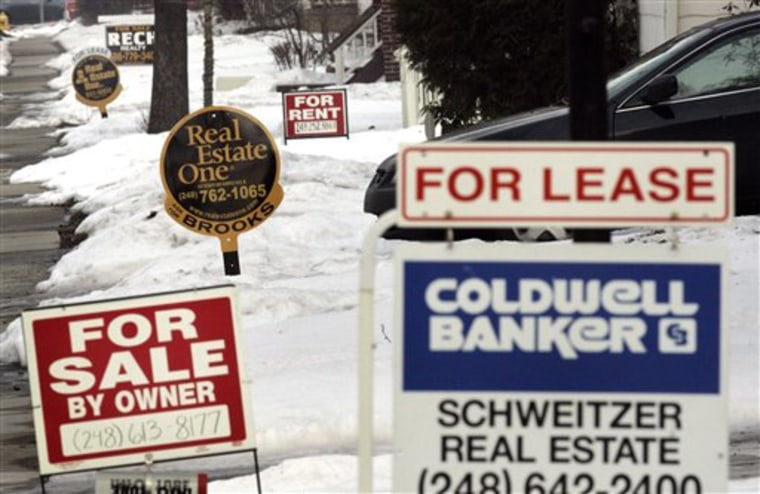Michigan and Ohio share something with Florida and California — some of the nation's highest rates of foreclosed homes and delinquent mortgages. But the reasons for their woes are as different as their climates.
Battered by a declining manufacturing base, stagnant population growth and low demand for housing, Michigan and Ohio rank No. 1 and 2 on mortgage finance company Fannie Mae's list of states with the largest credit losses through Sept. 30.
Fannie Mae, which finances or guarantees one of every five home loans in the United States, listed losses — loans written off as having no chance of being recovered — of $185 million for Michigan and $101 million for Ohio — two similar states in many respects with strong ties to the auto industry. By contrast, California saw $30 million; Florida, $21 million.
"The underlying economies of Michigan and Ohio are that bad relative to California and Florida," said Doug Duncan, chief economist for the Mortgage Bankers Association. Michigan had the nation's highest unemployment rate in October at 7.7 percent; Ohio's rate was 5.9 percent. Both are above the national rate of 4.7 percent.
And jobs and income are all-important in keeping the housing market alive. Nationwide data from Countrywide Financial Corp., the nation's largest mortgage lender, found the No. 1 reason its customers have been defaulting on mortgage loans is because their income was cut. That accounted for almost 60 percent of its loan defaults in the first 10 months of this year. Once illness and divorce are factored in, cash-flow problems caused 80 percent of mortgage defaults nationwide, according to Countrywide's data; payment adjustments alone accounted for only 2 percent.
Phillip Hubbard of Flint, a town hard hit for decades by plant closings and immortalized by native Michael Moore in his 1989 film, "Roger & Me," knows first-hand how bad the housing market has become.
Hubbard, 39, said he left his job of 19 years in 2005 at a "mom-and-pop" auto parts store as he dealt with a form of muscular dystrophy and found physical aspects of the job difficult. He managed for nearly two years to pay his 30-year fixed mortgage on a small ranch home he bought six years ago his through disability checks and savings, but fell behind as gas prices, property taxes, utility bills and insurance premiums escalated.
He said he tried unsuccessfully to work out a new payment plan with his mortgage company. So he put the house up for sale in the spring and then let it go into foreclosure in October when he couldn't find a buyer.
Fannie Mae's report shows the Midwest in general is suffering the largest loan losses. Of the top seven states, five are in the Midwest, with Minnesota ranked third, Indiana fourth and Illinois seventh. California and Florida are ranked fifth and sixth, respectively.
Teresa Gordon, a Michigan-based owner of a real estate firm that specializes in foreclosure, said the economy is a factor in her region's mortgage mess but the blame goes around, including lenders that got too lenient and buyers who made poor decisions.
"I'm one of the few people that's going to capitalize on this. ... but it's only (for) so long," Gordon said.
Housing is a lagging indicator of an economic decline, said Duncan, pointing to the 340,000 jobs lost in Michigan and 200,000 in Ohio since 2001.
"People aren't moving out because of the weather but because of the lack of opportunity," he said.
Meanwhile, the mortgage problems in Florida and California were caused by a speculative bubble built on excess supply, he said.
"It's a different story."
Home foreclosures reached an all-time high nationwide in the third quarter, with Ohio the top state in percentage of loans in foreclosure, and ninth in delinquencies not yet in foreclosure, according to the latest report by the Mortgage Bankers Association. Michigan ranked second in delinquencies and third in foreclosure inventory.
Ohio, Michigan and Indiana were near the top in three important categories: foreclosure inventory and foreclosure starts and serious delinquencies, the share of loans at least 90 days past due or in the process of foreclosure.
"If you're losing population and jobs, that's not going to be good for housing. ... They both come out of demand side of equation, and loan quality is going to decline," Duncan said.
There are other differences in the regions.
Together, Ohio and Michigan represent about 6 percent of Fannie Mae's book of business. By contrast, California and Florida combined represent nearly 23 percent of the company's book of business.
Florida and California are markets dominated by adjustable-rate mortgages while Midwest homeowners usually have fixed rates where Fannie Mae has a much stronger presence. Also, Fannie Mae has a $417,000 loan limit, keeping it out of many markets in both states.
Hubbard, who last month moved into a mobile home he bought from a friend, plans to get his associate's degree from a community college this spring, and then transfer to University of Michigan-Flint to earn his bachelor's degree in education and become a high school history teacher.
He hopes his financial turnaround coincides with the state's, but he's ready for whatever comes.
"My house now has wheels under it and I've joked a few times about renting a U-Haul truck and dragging it to where I can find work," he said.
